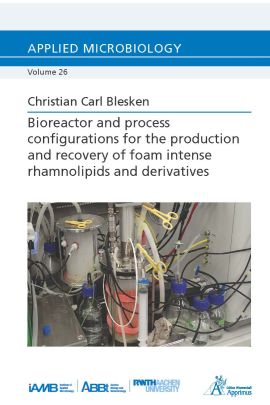Rhamnolipids (RLs) and the RL precursors, 3-(3-hydroxyalkonoyloxy)alkanoates (HAAs) can nowadays be produced by non-pathogenic Pseudomonads. Numerous economically relevant applications for RLs, e.g. in environmental protection, in the agricultural sector, in medicine, cosmetics and food industry, and as detergents are discussed. Some RL containing products are already established on the market like household cleaners, toothpastes, or skin care products. The exclusive synthesis of HAAs has only recently been realized, providing a basis for the use of HAAs as a platform molecule for versatile applications. In this study, the production of RLs and HAAs is carried out by performing a scale-up from shake flask cultures to bioreactors. The extracellular secretion of the excessively foaming product enables a direct product separation from the cultivation process. Product separation with the foam that is formed in the reactor headspace is considered as a particularly elegant technique. This foam is stabilized by the secreted RLs and HAAs, which reduce the interfacial tension in the gas-liquid interface due to the biosurfactants' characteristic amphiphilic structure. In this context, bioreactor processes for integrated foam fractionation, i.e. surfactant enrichment in the foam by draining of the entrapped culture broth, are shown. The co-accumulation of biomass in the foam was considered as major challenge for a stable bioreactor process. Cell-surface structures contributing to bacterial adhesion onto the gas bubbles in the foam were identified by investigating cell-surface hydrophobicities of specific deletion mutants. Here, the flagellum and adhesins for biofilm formation were determined to be particularly relevant. A correspondent genetic deletion in the RL and HAA producing strains reduced biomass enrichment in the foam. In the following, a reactor process with an external fractionation column for foam fractionation decoupled from the cultivation process, was implemented. The fractionated foam was further processed by foam adsorption. The biosurfactant adsorbs on a hydrophobic surface and is thus completely separated from the culture broth in the foam. Consequently, intensified RL and HAA production and recovery could be demonstrated within this thesis to showcase a sustainable provision of economically relevant surfactants.
| Autor | Blesken, Christian Carl |
|---|---|
| Gewicht | 0.278 kg |
| Erscheinungsdatum | 10.11.2021 |
Institut für Angewandte Mikrobiologie (iAMB)
Bioreactor and process configurations for the production and recovery of foam intense rhamnolipids and derivatives
Kurzbeschreibung
In this study, a recombinant non-pathogenic Pseudomonas putida KT2440 was applied for rhamnolipid or 3-(3-hydroxyalkanoyloxy)alkanoic acid production. The production and recovery of these surfactants was intensified by the integration of foam fractionation and desorption techniques into the bioreactor cultivation process. Furthermore, the accumulation of bacteria at the gas-liquid interface of the foam could be diminished by deleting genes encoding hydrophobic cell-surface structures.

